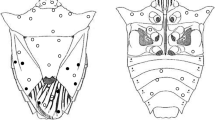Abstract
Dormancy is described for adults of the stalk-eyed fly, Diopsis longicornis Macquart (Diopsidae: Diptera) in the tropical savanna of coastal Guinée, West Africa. Populations of diopsids maintained themselves within each chosen refugium throughout the dry season unless the site dried up. Sex ratio within the populations at each refugium remained constant throughout the dry period. Slightly more females than males were found (56%), and of these only 0.8% were gravid. Movement of stalk-eyed fly adults from the rice field to the refugia corresponded with the end of the rice cropping period (stage of ripening and harvest) at the end of the wet season (late October to November), whereas movement from the refugia to the rice field occurred towards the end of the dry season Gate (May/early June), but well in advance of the rice crop planting (July and August) of the following wet season. Insects retained their state of reproductive arrest in the dry season even when offered suitable oviposition sites, i.e. rice plants. Secondary host plants were investigated as possible oviposition sites and food sources for adult flies.
Résumé
La période de dormance est décrite pour le stade adulte de Diopsis longicornis Macquart (Diopsidae: Diptera) un ravageur de riz de la savanne tropicale guinéenne de l’Afrique de l’Ouest. Les populations de diopsidés ont demeuré dans leurs sites de refuge respectifs pendant la saison sèche sauf dans les sites qui se sont assèchés. Le rapport male: femelle est demeuré stable pendant ce stade de dormance reproductive. Le taux de femelles était légèrement plus élevé (56%) et de celles-ci seulement 0.8% portait des oeufs. À la fin de la saison pluvieuse, la migration de D. longicornis depuis les champs de riz vers les sites de refuge coincide avec la récolte de cette culture (fin octobre et novembre); par contre les diopsidés quittent ces sites en fin de saison sèche (mai et début juin) bien avant le début de la prochaine campagne de riz (juillet et août) en saison pluvieuse. Ces insectes ont maintenu leur période d’arrêt reproductif en saison sèche même en présence de leur plante-hôte, le riz. Les plantes-hôtes secondaires de D. longicornis ont également été évaluées au cours des deux saisons climatiques pour leur importance comme sites de ponte et de sources de nourriture.
Similar content being viewed by others
References
Andrewartha H. G. and Birch L. C. (1984) The Ecological Web: More on the Distribution and Abundance of Animals. University of Chicago Press, Chicago, 506 pp.
Anonymous (1970) Pest control of rice. PANS Manual No. 3. Mia Overseas Development, London, 270 pp.
Chiasson H. and Hill S. B. (1993) Population density, development and behaviour of Diopsis longicornis and D. apicalis (Diptera: Diopsidae) on rice in the republic of Guinée. Bull. Entomol. Res. 83, 5–14.
Danks H. V. (1987) Insect dormancy: An ecological perspective. Biological Survey of Canada Monograph Series 1, Ottawa, 439 pp.
Deeming J. C. (1982) Hostplant records for some Nigerian Diopsis species (Dipt., Diopsidae). Entomol. Mon. Mag. 118, 212.
Delfinado M. D., Hardy D. E., Hidaka T., Vungsilabutr P. and Kadkao S. (1974) Studies on the ecology and control of the rice gall midge in Thailand. TARC Tech. Bull. 6, 113 pp.
Denlinger D. L. (1986) Dormancy in tropical insects. Annu. Rev. Entomol. 31, 239–264.
Descamps M. (1957) Contribution à l’étude des diptères Diopsidae nuisibles au riz dans le nord Cameroun. J. Agric. Trop. Bot. Appl. 4, 83–93.
Feijen H. (1984) Studies on the Systematics, Ecology and Economic Importance of the Diopsioinea (Diptera). PhD thesis, Leiden University, Leiden, The Netherlands.
Hidaka T. and Yaklai V. (1980) Ecology and control of the rice gall midge with special emphasis on measures to prevent its spread in Thailand. Paper presented at the 12th Meeting of the FAO Plant Prot. Committee, 27 October to 3 November, 1980, Chiengmai, Thailand.
Hidaka T., Yaklai V., Chantaraprapha N. and Chantarasaart S. (1978) Serious incidence of the rice gall midge in the Central Plain of Thailand. Appl. Entomol. Zool. 13, 260–263.
Hodek I. (1973) Biology ofCoccinellidae. Junk, The Hague. 260 pp.
Jordan F. J. (1966) Investigations into the Presence and Prevalence of Rice Stemborers and Their Parasites in Sierra Leone, 1964–1965. Report of West African Rice Res. Stn., Rokupr, Sierra Leone. IRRI, Los Baños, Philippines, 47 pp.
Lever R. J. A. W. (1969) The current position on the control of insect pests of rice. CIBA Agrochemicals Technical Monograph 1, 32–38.
Loevinsohn M. (1994) Rice pests and agricultural environments, pp. 483–508. In Biology and Management of Rice Insects (Edited by E. A. Heinrichs). Wiley-Eastern, New Delhi.
Morgan H. G. and Abu J. F. (1972) Weed hosts of diopsid (Dipt.) rice stemborers in Ghana. Entomol. Mon. Mag. 108, 105–106.
Oka H. I. (1988) Origin of Cultivated Rice. Developments in Crop Science No. 14. Japan Sci. Soc. Press, Elsevier, Tokyo, 254 pp.
Onate B. T. (1965) Egg parasites, particularly Anagrus nr. flaveolus (Hymenoptera: Mymaridae), parasitic to the eggs of Laodelphax striatellus and other rice-infesting planthoppers and leafhoppers. Rice Entomol. Newsl. 10, 42–43.
Taylor F. (1984) Mexican bean beetles mate successfully in diapause. Int. J. Invertebr. Reprod. Dev. 7, 297–302.
Author information
Authors and Affiliations
Additional information
See Editor’s Note at the end of this issue.
Rights and permissions
About this article
Cite this article
Chiasson, H., Hill, S.B. Dormancy in the Stalk-Eyed Fly, Diopsis Longicornis Macq., a Pest of Rice in Sub-Saharan Africa. Int J Trop Insect Sci 16, 303–310 (1995). https://doi.org/10.1017/S174275840001732X
Accepted:
Published:
Issue Date:
DOI: https://doi.org/10.1017/S174275840001732X
Key Words
- Diopsis longicornis
- Diopsidae
- Diptera
- dormancy
- tropical savanna
- refugia
- rice stemborer
- secondary host plants
- West Africa




